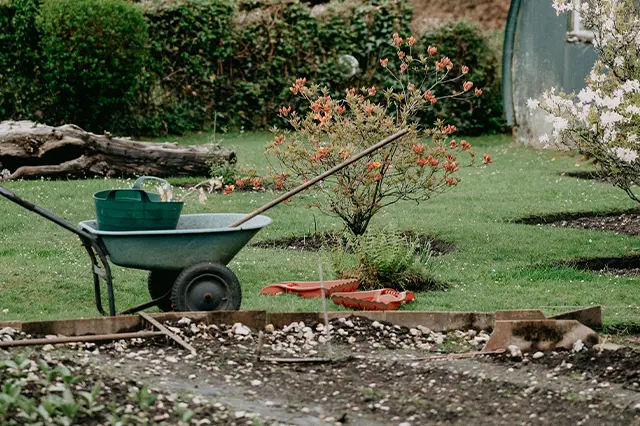
Transform Your Garden With These Creative Edging Ideas
Gardens are more than just a bit of ground to plant flowers and vegetables. They’re an opportunity to express your creativity, add beauty to your home, and reconnect with nature. But often, the most difficult part is deciding how to edge your garden. Do you go for the classic look of a well-manicured lawn? Or do you embrace a more natural approach with wood or stone? The possibilities are endless, so here are some creative edging ideas to help transform your garden into something extraordinary.
Garden Edging Ideas
If you’re looking for ways to transform your garden, adding some creative edging is a great place to start. Garden edging can help define the different areas of your garden, and give it a neat and tidy appearance. It can also be used to add some extra interest, and create a borders or patterns.
There are lots of different materials that can be used for garden edging, so you can choose something that suits your style and budget. Stone or brick edging can create a classic look, while timber edging is perfect for a more natural feel. There are also many different types of plastic edging available which is very affordable.
Once you’ve chosen your material, it’s time to start planning your design. Think about the different areas of your garden that you want to edge, and how you want the finished result to look. Do you want straight lines or curved edges? A simple border or something more elaborate?
When you’re ready to start installing your garden edging, make sure you have all the necessary tools and materials. If you’re using bricks or stones, you’ll need mortar as well as something to measure and mark out the area. For timber edging, you’ll need some saws and nails or screws. And if you’re using plastic edging, you’ll just need some strong tape or stakes to secure it in place.
Take your time when installing garden edging, and make sure everything is level and even. Once it’s in place, add some mulch or stones to help keep the area looking neat and tidy.
Garden edging can be a great way to add some extra style and interest to your garden. With so many different materials and designs available, you’re sure to find something that will work for your garden space.
How to Choose the Right Garden Edging
Choosing the right garden edging can make all the difference in the overall look of your garden. Here are a few things to keep in mind when choosing the perfect edging for your space:
-Think about the overall style of your garden. Do you want a more formal look or a more natural, relaxed feel?
-Choose an edging material that compliments the existing materials in your garden. For example, if you have stone pavers in your garden, consider using stone or brick for your edging.
-Consider how much maintenance you are willing to do. Some edging materials, like concrete, will require more upkeep than others, like plastic.
-Think about what kind of plants and flowers you have in your garden. You’ll want to choose an edging material that won’t damage delicate roots or impede growth.
By following these simple tips, you’ll be sure to find the perfect garden edging for your space!
Different Types of Garden Edging
If you’re looking for a way to add more interest and structure to your garden, edging is a great solution. There are many different types of edging available, so you can choose the one that best suits your needs. Here are some of the most popular types of garden edging:
1. Brick or stone edging: This type of edging adds a classic touch to any garden. It’s also very durable and low-maintenance.
2. Wooden edging: Wood is a popular choice for garden edging because it’s relatively inexpensive and easy to work with. You can find pre-made wooden edging at most home improvement stores.
3. Landscape fabric edging: This type of edging is often used in professional landscaping applications. It’s made from a heavy-duty fabric that can withstand harsh weather conditions and foot traffic.
4. Plastic or metal edging: These materials are both durable and low-maintenance, making them ideal for busy households. They come in a variety of colors and styles to suit any taste.
5. Bamboo edging: This type of edging creates a natural, tropical look in your garden. It’s also very easy to install and requires minimal maintenance.
No matter which type of edging you choose, it’s important to make sure it’s properly installed so it lasts for many years to come.
Garden Edging Materials
Garden edging is a great way to make your garden stand out. It can also be used to create different areas in your garden or to define a certain space. There are many different types of edging materials available, so it’s important to choose one that will complement your garden and meet your needs.
Here are some of the most popular types of garden edging materials:
1. Brick
Brick is a classic choice for garden edging. It’s durable and long-lasting, and it can be used to create straight or curved edges. You can also use brick to create patterns or designs in your garden.
2. Stone
Stone is another popular option for garden edging. It has a natural look that can complement any type of garden, and it’s also very durable. Stone edging is available in a variety of colors and styles, so you’re sure to find one that matches your taste.
3. Concrete
Concrete is a versatile material that can be used to create just about any type of edge you want. It’s affordable and easy to work with, making it a popular choice for DIY projects. You can stain or paint concrete edging to match your garden décor.
4. Wood
Wood is another versatile material that can be used for both straight and curved edges. It has a natural look that adds warmth to any garden, and it’s also very affordable.
5. Metal
Metal edging is perfect for creating clean, crisp lines in your garden. It’s available in a variety of colors and styles, so you’re sure to find one that fits your needs.
No matter which type of edging material you choose, make sure to install it properly so it lasts for years to come.
Installation Tips
1. Start by defining the borders of your garden with string or garden hose. This will give you a clean lines to work with when installing your edging.
2. If you’re using pavers, bricks, or stones for your edging, be sure to dig a trench that’s at least 2 inches deep to accommodate for the thickness of the material.
3. When installing wooden edging, it’s important to use rot-resistant lumber like cedar or treated pine. Dig a shallow trench for the boards and secure them in place with landscape staples.
4. For a more natural look, try using logs or branches as garden edging. Simply position them in place and secure with landscape stakes if needed.
5. If you’re using metal edging, be sure to drive the edging stakes approximately 8 inches into the ground and leave a gap of 6-8 inches between each stake.
6. Finally, fill in any gaps with soil or mulch, and water regularly to keep your edging looking its best.
With the right materials and installation techniques, your garden will look professionally landscaped in no time!
Maintenance and Care
When it comes to your garden, the little details make all the difference. The right edging can transform a patch of dirt into a beautiful and well-defined space. Here are some creative ideas to get you started:
1. Brick Edging
For a classic look, try brick edging. You can use reclaimed bricks for a rustic feel, or go for new ones for a more polished look. Either way, bricks are easy to work with and will give your garden a neat and tidy appearance.
2. Wooden Logs
If you’re looking for something a little different, try using wooden logs as edging. This is perfect for country gardens or if you want to add a natural touch to your space. Just make sure the logs are well-secured so they don’t start rolling away!
3. Paver Stones
Paver stones are another versatile option that can be used to create all sorts of looks, from classic to modern. Plus, they’re easy to install and can be found in most home improvement stores.
4. Garden Fencing
For a more formal look, consider using garden fencing as edging. This material can be quite pricey, but it will definitely give your garden an upscale appearance. Just be sure to choose a fence that’s tall enough to deter critters from getting in!
5. Hanging Baskets
If you’re short on space, artificial hanging baskets are a great option for adding some extra texture and color to your garden. They can be easily hung up on walls or fences and will instantly brighten up any area.
No matter which edging material you choose, it’s important to take proper care of it to ensure its longevity. Regularly check the edges for signs of wear and tear, and make sure they’re secured in place with stakes or other materials if necessary. If you opt for wooden logs, make sure they’re treated with a protective sealant to prevent rotting.

